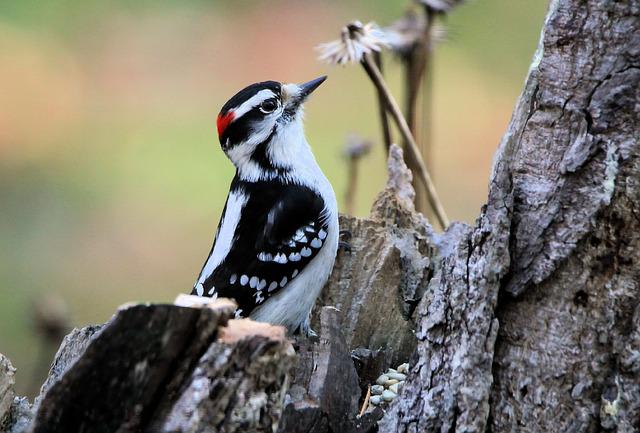Woodpeckers are some of the most interesting birds in the world. Not only are they known for their distinctive “woodpecker” sound, but they are also known for their habit of making holes into trees.
This pecking or drumming can leave behind some pretty noticeable holes in the tree bark. So, what does that hole look like and how do we know if a woodpecker made it?

Woodpecker Holes
A hole made by a woodpecker is usually oval or round in shape. It is also usually quite small, only about an inch or so in diameter. The hole will be smooth around the edges and will often have wood shavings or chips near it.
The depth of the hole will depend on how deep the woodpecker was pecking. Some woodpeckers will only peck the surface of the tree, while others will peck all the way through to the wood beneath the bark.
A pileated woodpecker, for example, will make a hole that is about 4 to 5 inches deep, while a red-bellied woodpecker will only make a shallow hole. Pileated woodpeckers are some of the largest woodpeckers in North America and can be found in forests throughout the eastern United States.
Other animals, like squirrels, can also make holes in trees, but their holes will be much larger than a woodpecker’s hole.
Did A Woodpecker Make That Hole?
There are a few other things to look for that can help you tell if a woodpecker made the hole. First, take a look at where the hole is located on the tree. Woodpeckers typically peck holes near the top of the tree, near branches, or on the trunk.
Another giveaway that a woodpecker made the hole is if there are small pieces of bark or wood chips around the hole. These chips are usually about the size of a pencil eraser and are left behind when the woodpecker is pecking.
Finally, take a look at the hole itself. If it is perfectly round or oval, it is likely that a woodpecker made it. Holes that are jagged or have rough edges are not typically made by woodpeckers.
Why Do Woodpeckers Peck Holes?
There are a few different reasons why woodpeckers peck holes. One reason is to find food. Woodpeckers will use their beaks to peck into the tree bark to find insects or grubs that they can eat.
These insects can be difficult to find, so the woodpecker will peck many holes in the tree to try to find them.
Another reason that woodpeckers peck holes is for communication. Woodpeckers will often peck a hole in a tree and then make a “drumming” sound by rapidly tapping their beaks on the tree.
This drumming can be used to communicate with other woodpeckers or to attract mates. Downy woodpeckers, for example, will use their drumming to warn others away from their territory. A downy woodpecker creates a “drumming” sound by rapidly tapping its beak on a tree.
Woodpeckers will also sometimes peck holes in trees to create nesting cavities. These cavities are used to raise their young and can be reused year after year.
Finally, some woodpeckers will peck holes in trees simply because they enjoy it! These birds have very strong beaks and love to use them to peck at things. Pecking holes in trees is just another way for them to play and have fun.

What’s Inside A Woodpecker Nest Hole?
Woodpeckers are cavity-nesting birds, which means they build their nests inside holes in trees. Woodpecker nest holes are typically round or oval in shape and are just big enough for the bird to fit inside.
The inside of a woodpecker nest hole is lined with soft materials such as wood chips, leaves, and feathers. These materials help to keep the eggs and young chicks warm and protected. The number of eggs laid by a woodpecker varies depending on the species but is usually between four and eight.
Once the eggs hatch, the young chicks will stay in the nest for several weeks before they are big enough to leave. During this time, the parents will take turns incubating the eggs and feeding the chicks. Once the chicks are ready to leave the nest, they will begin to explore their surroundings and learn how to find food on their own.
Woodpecker nests can be found in a variety of locations, including dead trees, live trees, stumps, and even buildings. Some species of woodpeckers will even use man-made nesting boxes.
How Do You Fix A Woodpecker Hole?
Woodpeckers are pretty indiscriminate when it comes to where they peck. It doesn’t matter if it’s the tree trunks of your ornamental trees, your home’s siding, or your brand new fence, these birds will peck anything that strikes their fancy.
While woodpecker holes may not be aesthetically pleasing, they usually don’t cause any lasting damage to the tree or structure. However, if you are concerned about the hole, there are a few things you can do to fix it.
One option is to simply cover the hole with a piece of tape or putty. This will not only conceal the hole but also deter the woodpecker from pecking more holes in the same spot.
Another option is to fill the hole with a substance that will harden over time, such as epoxy resin. This will not only fill the hole but also make it more difficult for the woodpecker to peck through.

Does Woodpecker Holes Harm The Tree?
Woodpeckers are known for their ability to drill many holes into trees. But does this harm the tree?
The holes created by woodpeckers are generally not large enough to cause serious damage to the tree. In fact, many birds and animals use these holes for nesting or roosting.
However, if a woodpecker repeatedly pecks the same hole, it can eventually weaken the tree. This can make the tree more susceptible to disease or breakage. Additionally, if the woodpecker pecks too close to the trunk of the tree, it can damage the bark and affect the tree’s ability to transport water and nutrients.
This is called girdling, and it can be fatal to the tree.
While woodpeckers are generally harmless to trees, it is important to keep an eye on any holes that are being created. If you notice that a hole is becoming larger or more numerous, it may be time to take action.
How to Stop Woodpeckers From Pecking At Your Tree?
There are a few things you can do to deter woodpeckers from pecking holes in your trees. One option is to cover the area with chicken wire or another type of fencing. This will not only discourage the woodpecker from pecking but also protect the tree from further damage.
Another option is to use a bird deterrent such as a scarecrow or noise maker. These devices will make the area less appealing to birds and may cause the woodpecker to find a new place to peck.
When it comes to woodpeckers, an ounce of prevention is worth a pound of cure. By taking steps to deter these birds, you can protect your trees from damage.

Common Woodpecker Species
There are many species of woodpeckers, but only a few are commonly found in North America.
The most common species is the downy woodpecker. These birds are small, with black and white plumage. They can be found in a variety of habitats, including forests, parks, and even backyards.
Another common species is the red-bellied woodpecker. These birds are slightly larger than downy woodpeckers and have a red plumage on their belly. They are often found in wooded areas, but can also be seen in suburban neighborhoods.
The third most common species is the red-headed woodpecker. As their name implies, these birds have a red head. They are larger than both downy and red-bellied woodpeckers and are typically found in open areas such as fields and meadows.
While these are the most common species of woodpeckers, there are many other less common varieties. These include the yellow-bellied sapsucker, the pileated woodpecker, and the northern flicker.
No matter what type of woodpecker you see, one thing is for sure – these bird species are sure to make a lasting impression!
Final Words
Woodpecker holes may not be very pretty, but they are a part of nature. These holes can provide homes for other animals, and can even help the tree to grow. While woodpeckers may be a nuisance, they are generally harmless to trees.
If you are concerned about the damage that woodpeckers may cause, don’t. The holes are perfectly normal and won’t harm the tree.




